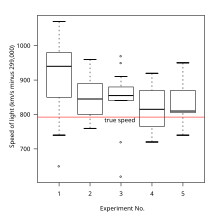This article needs additional citations for verification. (July 2021) |

In statistics, the sample maximum and sample minimum, also called the largest observation and smallest observation, are the values of the greatest and least elements of a sample.[1] They are basic summary statistics, used in descriptive statistics such as the five-number summary and Bowley's seven-figure summary and the associated box plot.
The minimum and the maximum value are the first and last order statistics (often denoted X(1) and X(n) respectively, for a sample size of n).
If the sample has outliers, they necessarily include the sample maximum or sample minimum, or both, depending on whether they are extremely high or low. However, the sample maximum and minimum need not be outliers, if they are not unusually far from other observations.
- ^ "NEDARC - Min, Max, and Range". www.nedarc.org. Retrieved 2023-02-17.